Content
Tinder fungus and chaga are parasitic species that grow on tree trunks. The latter can often be found on a birch, which is why it received the appropriate name - a birch mushroom. Despite a similar habitat, these varieties of tinder fungus are strikingly different not only in appearance, but also in properties.
What is chaga
This is a species of Basidiomycetes of the genus Inonotus. Chaga is the only name for the sterile form of the birch mushroom. In the literature, you can find other names of the described species - beveled polypore or Inonotus beveled. You can find such a basidiomycete not only on birch, but also on maple, elm, beech, alder. If a tree has a break, damage to the bark, and spores of the parasitic organism Inonotusobliquus get into it, as a result of this infection, chaga is formed.
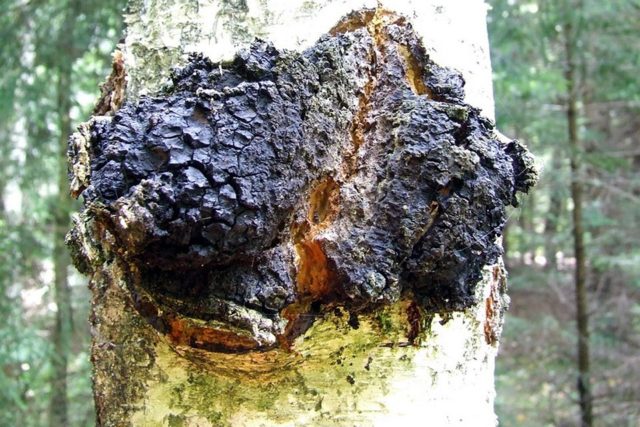
A few years after the lesion, an irregularly shaped fruit body is formed on the tree trunk.
It grows over the decades, in contrast to the tinder fungus, which matures over the season. As a result, the beveled inonotus can be up to 30 cm in diameter and up to 15 cm in thickness.
The color of the growth is bluish-black, the surface is uneven, covered with bumps and cracks. At the break, you can see that the inner part of the fruiting body is dark brown and is all permeated with white tubules. The growth of the mowed inonotus continues for 20 years, this leads to the death of the tree on which it settled.
What is a tinder fungus
This is a large group of saprophytes that belong to the section Basidiomycetes. They parasitize on wood, leading to the death of the plant. But, unlike chaga, tinder fungi sometimes grow in soil.
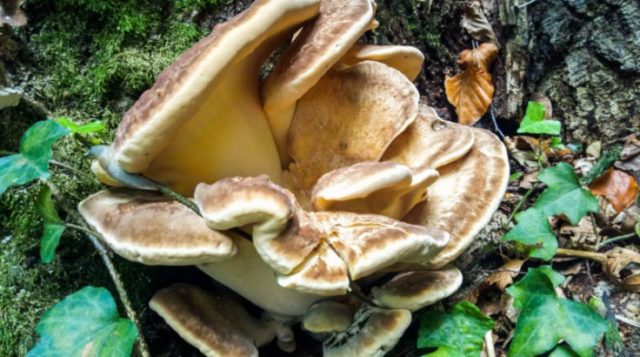
You can find them in park areas, in pastures, along the roadside.
In contrast to the canted inonotus, tinder fungi have prostrate, sedentary bodies in the form of a semicircle, a flattened sponge or a large hoof. The consistency of their pulp is hard, woody, corky or spongy.

The stem of the fruiting body is often absent.
But there are known species in which this part of the sporocarp did not atrophy.
This group of basidiomycetes is characterized by a tubular hymenophore, but some representatives of the species are distinguished by a spongy structure. The shape and weight of different types of tinder mushrooms is strikingly different. Some specimens can be up to 1.5 m in size and weigh up to 2-3 kg.
How to distinguish tinder fungus from chaga
Chaga, unlike tinder fungus, has an irregular shape in the form of a growth. Such a fungal organism can reach enormous sizes, affecting almost the entire trunk of a birch or other type of deciduous tree. Tinder fungi grow locally, encircling the trunk, creating a semicircle shape. Several more specimens of this species may be found nearby.
In the photo of chaga and tinder fungus, you can see that the surface of a birch mushroom is always black and loose, unlike tinder fungus.
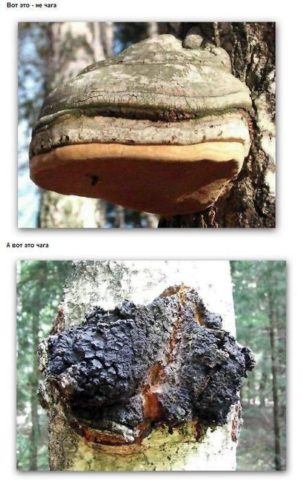
The birch mushroom is famous for its variety of colors, depending on the species, and smooth, velvety skin

In humid weather, polypore mushrooms release water droplets on the surface, the beveled inonotus remains dry
Chaga grows and develops on faults, damaged areas of wood, in contrast to it, tinder fungus grows everywhere.
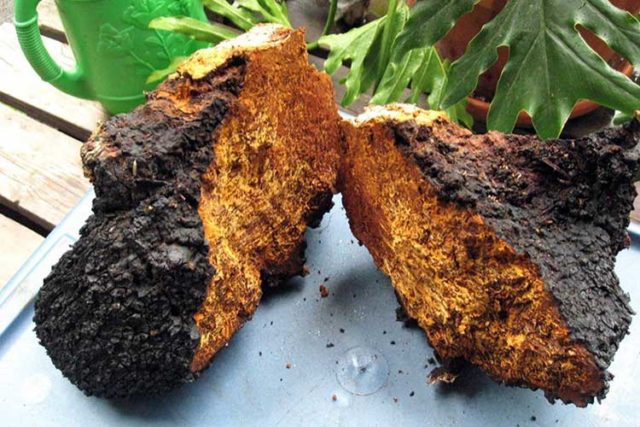
The inner part of the birch outgrowth is bright yellow, orange, in the tinder fungus it is white, light gray, yellowish or cream
The places where the inonotus adjoins the tree contains wood in the composition, in contrast to it, the fruiting body of the tinder fungus consists only of its cells.
The tinder fungus is easy to separate from the tree, in contrast to the beveled inonotus, which is almost impossible to remove without the help of a tool.
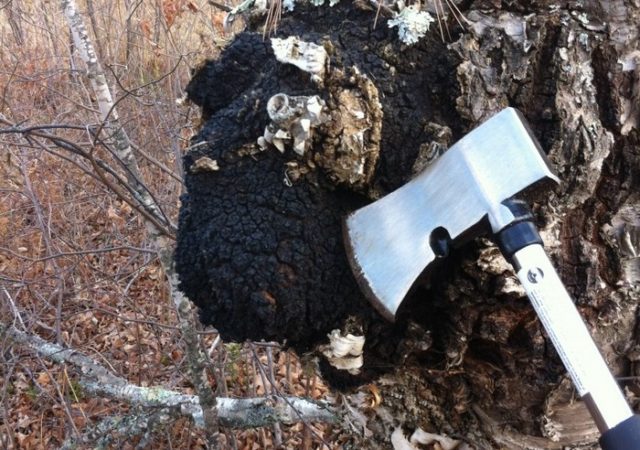
Basically in Siberia, it is cut down with an ax, then cleaned from the remains of wood
There is an opinion that birch tinder fungus and chaga are one and the same, but this is not entirely true. The beveled inonotus is popularly called the birch mushroom, but these species have a lot of differences. Experienced mushroom pickers in the video clearly show how to distinguish chaga from tinder fungus:
The use of chaga
Only the growths formed on the birch are considered medicinal. They contain resins, agaric acid, manganese in large quantities. Traditional medicine suggests that chaga is able to increase immunity, improve metabolism, relieve chronic fatigue syndrome, gastritis and ulcers.

Collected inonotus beveled for medical purposes, starting in August
There is evidence that the use of tea with the addition of dried Basidiomycete relieves cancer tumors, but this has not been scientifically proven. The growth is cleaned from the tree with an ax, the light woody part is removed, the mushroom is divided into small parts. Then the raw materials are dried in the fresh air or in an oven at a temperature not higher than + 60 ᵒС.
Chaga is used as a healing tea. A small amount of dried, crushed fruit body is steamed with boiling water, insisted and drunk like tea. Also, inonotus beveled is used for the preparation of healing baths that cleanse the skin.
In the pharmaceutical industry, biologically active additives and suppositories are made, which contain chaga extract.
Use of tinder fungus
Some varieties of this class are also used in traditional medicine. For example, bordered tinder fungus is used to treat liver, diseases of the gastrointestinal tract.
Other diseases curable with tinder fungus:
- incoagulability of blood;
- diseases of the genitourinary system;
- gout;
- insomnia;
- obesity.
Unlike the canted inonotus, this basidiomycete is also used in everyday life. The dried fruit body of the saprophyte is useful for lighting stoves and fireplaces. If you set fire to a dry piece of pulp and leave it to smolder, you can get rid of annoying insects in the room for a long time.
Conclusion
Tinder fungus and chaga are parasitic organisms that have a lot of external differences. The only similarity is that they destroy the trees they grow on. Unlike tinder fungus, inonotus canted has a woody structure and grows directly from the trunk, it is easy to recognize by its loose structure and black color. Tinder fungus is attached to the side of the wood, its pulp is spongy, and its color and shape are varied. There are many differences between these basidiomycetes, therefore, having studied their description in detail, it is difficult to make a mistake in choosing.








